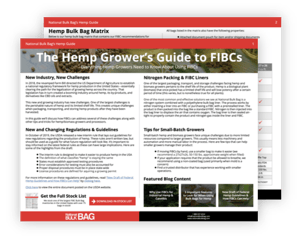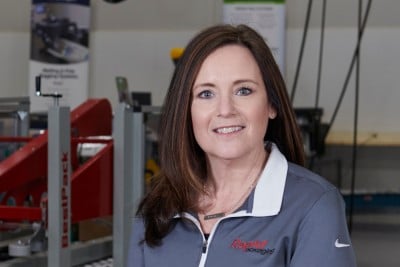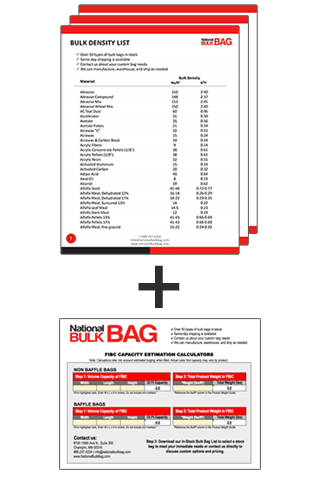As the hemp and biomass industry continues to grow in the US, a diverse field of growers and farmers is also emerging. With this diversity comes different needs, challenges, and day-to-day operations. One of the more defining characteristics of each individual operation is the size. The size of an operation impacts so much of the other parts of the business. Everything from growing, processing, storage and transportation – all of these things are impacted by the size of an operation in some way.
In our experience, the growers that face the most challenges and obstacles are small-batch growers. Usually strapped for resources and lacking the industrial machinery and equipment of the larger operations, these growers must find unique and innovative solutions to their daily problems. Let’s explore the different ways bulk bags can help small-batch hemp and biomass growers.
Challenges Facing Small-Batch Growers
Federal regulations around growing hemp, the production of CBD products, and state-level regulations often limit the amount of hemp that can be grown and by-products that can be produced by any individual operation. This has led to a massive increase in the number small-batch growers that have the ability to stay within the limits of these regulations. A small-batch grower is generally defined as producing 50 lbs of product or less at a single time (note: this is not a technical definition. However, it is based on our experience with the industry and other industry experts).
These small-batch growers face unique challenges that are different from larger growers. The lack of access to large resource pools that benefit larger growers leads to another crucial challenge – the lack of industrial equipment. This generally leads to no bulk bag filling equipment, no forklifts for moving massive amounts of weight, and generally no processing equipment. The result of this lack of heavy machinery means doing many of these tasks manually (by hand). Doing these tasks by hand necessitates the use of a smaller FIBC, thus significantly reducing the operational efficiency of these small-batch growers. Big operations using larger bags that can be handled with forklifts and used with filling/discharging equipment is a significant advantage for larger operations when compared to their smaller competitors.
How Your Distributor (and FIBCs) Can Help
If you don’t plan on using a bag with liner setup as described above, what kind of bag do we recommend? We recommend avoiding a coating in order to allow the product to breathe. This is especially important for hemp (and all biomass) because of the increased risk of molding if the product receives no air flow as even dried hemp has some moisture content.
Another option is a vented bag. Vented bags allow even more air flow versus a standard non-coated bag. This can often come down to preference of the user, but it is recommended that hemp and biomass producers use a solution that allows airflow to minimize the risk of molding.
Talk to Your Distributor?
Sometimes at National Bulk Bag, we feel like a broken record. We must stress the importance of your relationship with your bulk bag distributor. Quality distributors can help you find FIBC solutions that can accommodate the needs of small-batch growers. They also have access to specialized bags that address some of the challenges small-batch growers face.
For example, since these growers must do most of the filling, discharging, and transportation of the harvested hemp product by hand, a smaller FIBC is a great fit. We recommend a maximum size of 27 x 27 x 26 bag that has a 12 cubic foot capacity. This bag is fantastic for manual operation as it’s filled weight (biomass) ranges from about 50 to 150 lbs. When filled, the diameter of the bag doesn’t exceed 34 inches making it much easier to handle than a full-sized bag.
If your organization does have access to forklifts and other hauling equipment, a larger bag will help with operational efficiency. We recommend using a specialty bag with an oversized spout on the bottom of the bag to make biomass discharge easier. When using a standard sized discharge spout, moist biomass products can often become lodged in the spout, clogging it and stopping the product from leaving the bag.
Everything You Need to Know about Using FIBCs with Hemp.
 The booming hemp industry is creating unique challenges for growers and processors alike. With the lack of reliable education on the internet, the hemp industry is commonly asking questions like how do I properly store my hemp and biomass? How can I extend my product’s shelf-life? How can I reduce the risk of mold and contamination? Is there an easier way to empty my bulk bags?
The booming hemp industry is creating unique challenges for growers and processors alike. With the lack of reliable education on the internet, the hemp industry is commonly asking questions like how do I properly store my hemp and biomass? How can I extend my product’s shelf-life? How can I reduce the risk of mold and contamination? Is there an easier way to empty my bulk bags?
In our new Hemp Grower's Guide to FIBCS, we discuss how FIBCs can help address the various challenges hemp growers face.







